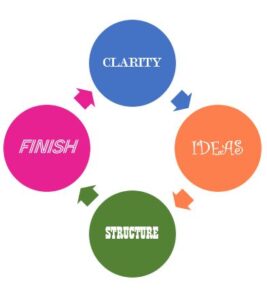When you’re thinking creatively – like to write, or draw, or solve a hard problem – what exactly is going on in your brain? You may think it is dark and mysterious, indecipherable and vulnerable, even magic. And it is, in its outcomes, but the basic mechanics are pretty known, and knowable.
How the brain works when creating has been the subject of about 60 years of study and research by psychologists and Creative Studies practitioners. Thousands of experiments have been conducted on tens of thousands of subjects to better understand creative thinking, and what is going on in there?
Scientists observed creative people in various settings and constraints and worked to define the types of thinking it took to “create.” My model for that research – which I call Deliberate Creativity – is below, and is based on the Foursight model, the most widely used and accepted model for how creative thinking works. (The Foursight model, was developed by Dr. Gerard Puccio, chair of the International Center for Studies in Creativity Buffalo State College, where I got my Masters degree.)

1.) You seek CLARITY
2.) You come up with IDEAS
3.) You put your ideas into a STRUCTURE
4.)You FINISH
This is an observed process, i.e. this is not instructional, “Do this first, and then this.” It is a definition of what our mind does naturally when our creative thinking is successful. And since it is how our brain works when we’re creating, this process applies in a micro and macro situation. This whole process happens when you do something small, like name a character, and will happen when you write a whole book or script, with many, many micro cycles within the big creative cycle.
These four phases and thinking styles occur in sequence inside your creative brain. Every time.
I’m going to define these four thinking styles and what helps lubricate the gears in your brain when you get stuck. Stuck or procrastinating is often a symptom of not transitioning well between thought phases, or being square in a phase that drains you of energy.
What defines CLARIFYING thinking?
When you CLARIFY, you define the problem. You are working to make sure you are solving the right problems, creating the right work, using the right voice/medium, etc.
- DO: You seek gaps, needs and holes in your understanding. You identify challenges & strategize your approach to the whole undertaking.
- THINK: Your thinking is strategic, expansive, visionary
- FEEL: Your emotional state should be open, empathetic, thorough, patient.
You want to GET IT RIGHT.
What defines IDEATIONAL thinking?
When you come up with IDEAS you spitball. You come up with lots of possible ideas to meet the challenges. You’re working to make sure you push yourself beyond the conventional thinking into weird, interesting, new ideas
- DO: come up lots of ideas, seek new possibilities and solutions
- THINK: Your thinking is expansive, divergent, flexible, far-ranging, and 100% non-judgmental.
- FEEL: Your emotional state should be playful, fun, humorous, outlandish, permissive.
You want to GET THE BIG IDEA.
What defines STRUCTURAL thinking?
When you seek STRUCTURE, you focus. You select the appropriate ideas and you create and perfect your product. You’re working to develop concepts into your vision.
- DO: Select, develop, perfect
- THINK: Your thinking is evaluative, critical, decisive.
- FEEL: Your emotional state should be focused, immersed
You want to GET IT PERFECT.
What defines FINISHING thinking?
When you FINISH, you shift toward end-game thinking. You are preparing and sharing the work with the world, (whether that’s one or a million people). You work to find and tap into acceptance of the idea and/or product.
- DO: Prepare and share the work with the outside world
- THINK: Your thinking is tactical, contextual, “other” minded, fast-thinking
- FEEL: Your emotional state should be opportunistic, demanding, energetic
You want to GET IT DONE.
That’s the four phases of creative thinking and how they should be approached and completed for best creative effect. If you have a favorite phase of creativity, it is often because you excel at that type of thinking, and enjoy that emotional state. But if you’re stuck or stalled, you might look at what thinking style is next in the process of what you’re trying to create, and see if your mood or mindset is in resistance to what that phase of creativity needs.